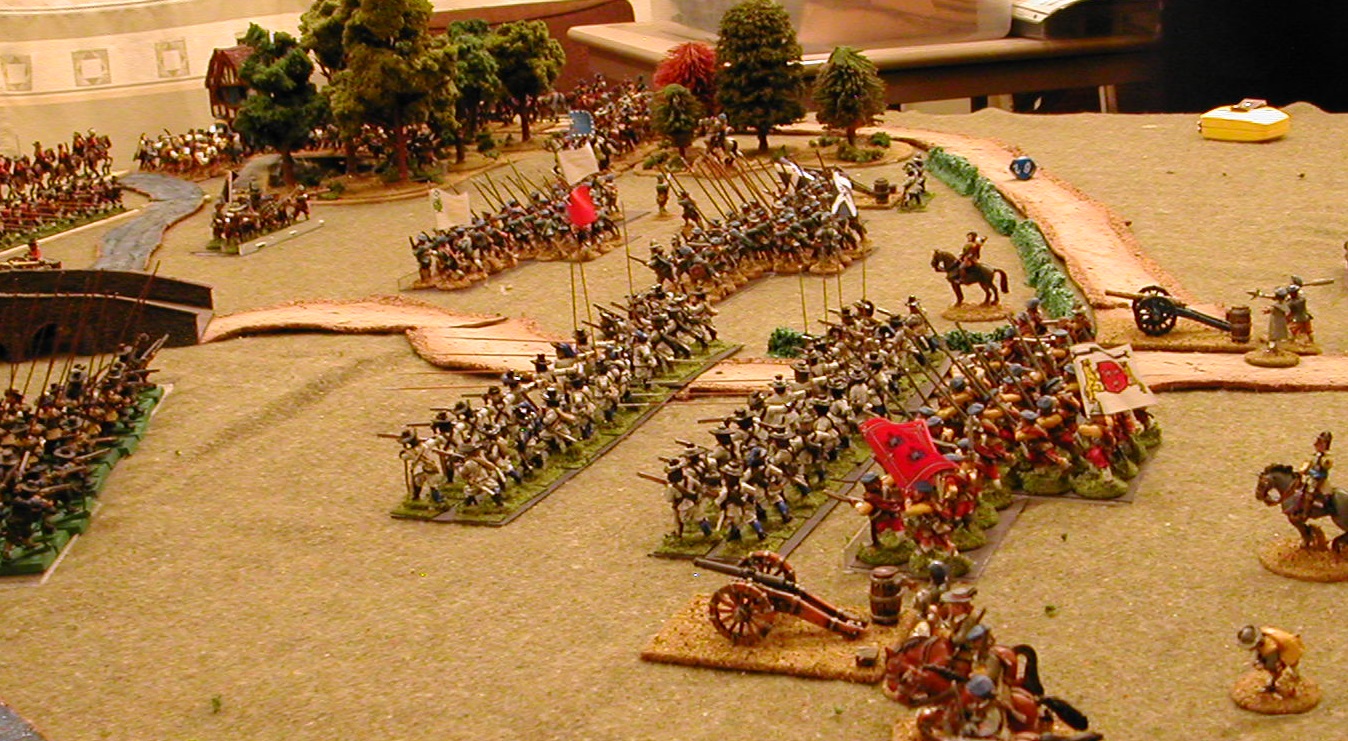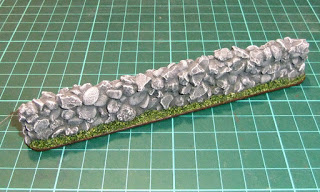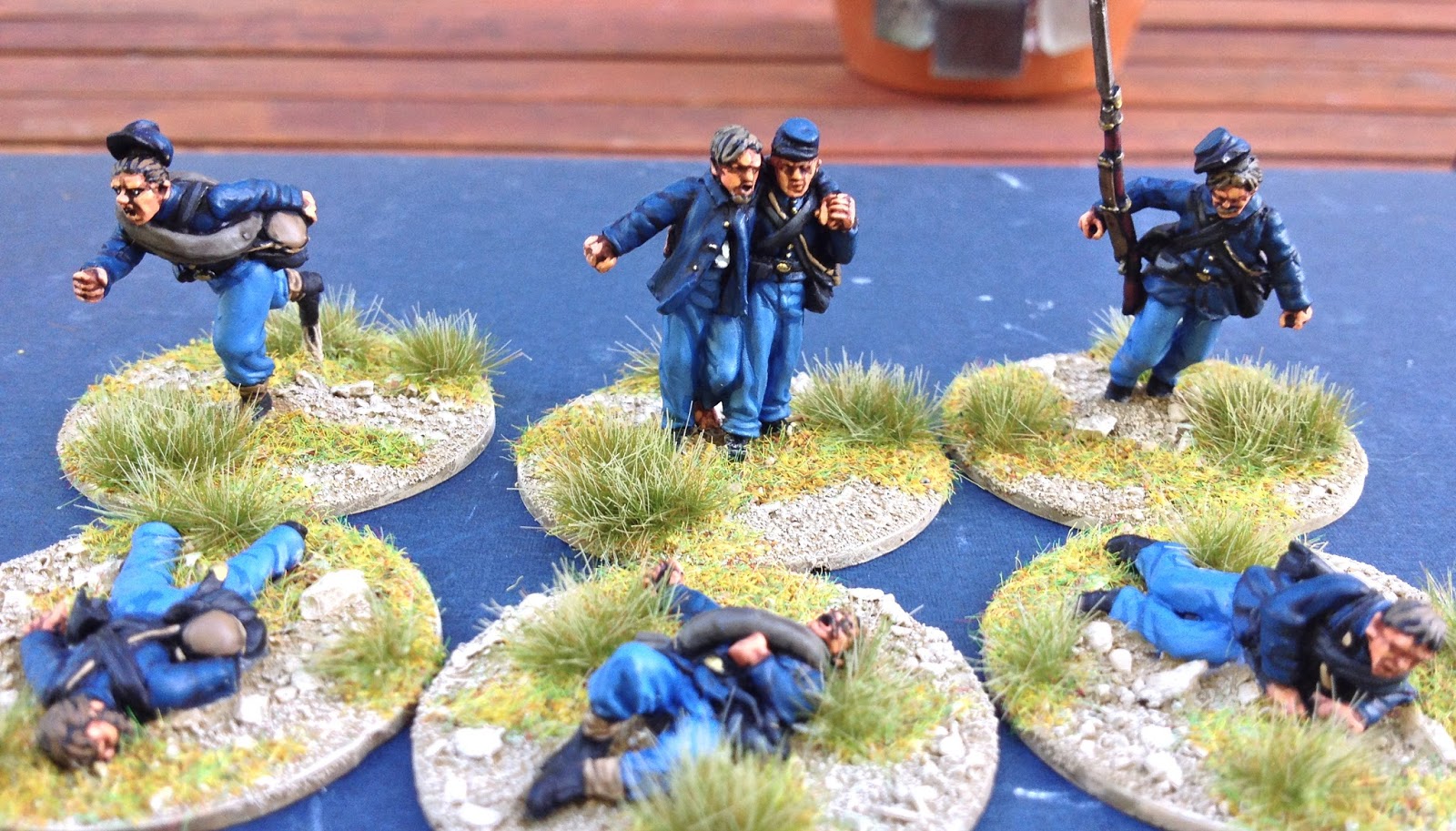
Even a very simple wargames table can look OK (well, at least not horrible)
(Note: If you already have a great-looking wargames table, then you are probably wasting your time reading this. I have noticed, however, that not everybody does - if you are one of those "not everybody" then please read on!)
For many years, I don't suppose I was any different than many historical miniatures wargamers when it came to terrain - yes, you need it and no, it isn't as important as having nice figures in your armies. This attitude is understandable - historical miniatures - especially in the quantities required by most games - aren't cheap, and they require a lot of time and energy (or a lot more money) to get onto the table, painted and ready for play. Without the miniature soldiers, there's no game. Terrain is an after-thought - a few oblong patches of brown cloth for woods, with a few foliage clusters on them, and a bit of masking tape for roads, and you're good, right? Maybe a building or two - and if you're completely out of cash, you can download paper ones for free, print them, and put them together. Slide a book underneath the kelly-green piece of felt you use for a ground cloth, and you've got a hill. Good enough is good enough.
Wrong.
The problem with this attitude, understandable as it may be, is that the table ends up looking terrible. You can have the best-painted miniatures in the world, and if the terrain looks like crap, then the whole table does, and the beautiful paint jobs on your soldiers are wasted. We should look at our wargames tables as if they were dioramas - yes, the soldiers should be well-painted and look good, but so should their battlefield. It is what sets us apart from board-gamers and video-gamers: we create amazing miniature models of battles, and then we get to bring them to life. You don't need to go through all the trouble and expense of collecting miniatures to play a strategy game - we do it because we want something more! This is, of course, only one gamer's opinion. But I feel more and more strongly about it the longer I am in the hobby, and I'd like to trace the process by which I came to understand why it is so important.
Every time I go to a convention, certain games stand out because they are simply beautiful to look at. Even if I am only walking past the table, it is always wonderful to see someone running a game which looks like a real battlefield - it helps us to immerse ourselves in the experience, and to live a little bit of the history which fascinates us. I probably won't ever be the guy putting on the most gorgeous games at a convention, but I can at least know that what I have done looks decent, even if it isn't winning any awards. It isn't a zero-sum equation - the better your table looks, the better your game, best or not.
Even if we can't always put together a stunning table, there is no reason our games shouldn't at least be presentable. The cost and effort required to make a table look acceptable is minimal, especially today when there is so much good information out there on the Web for making terrain. The biggest challenge is deciding to do it in the first place.

Even a very simple wargames table can look OK (well, at least not horrible)
I have always loved the strategy and rules design aspects of wargaming, even after I gave up playing video games and board games (they ate into the time I could be spending doing miniatures wargaming-related stuff). I have never been more than a competent painter or modeller. For years, I was happy to do what it seemed like everybody else did - green felt, a few oblong patches of brown cloth, a little lichen, etc. But as time went on, I began to gradually realize that what I had always thought of as "normal" actually wasn't anymore - it was shabby and looked terrible. The standard for acceptable terrain had gone up.
It was at about the time I noticed this that I moved, and ended up gaming with a crowd that included some really talented painters and modellers. The games in my new location were mostly done in 25mm, where before I had usually gamed in 15mm. And slowly I began to realize that there was an aspect to the hobby I had simply been ignoring. Some of the games I was playing were really well done, and all of them met a minimum for aesthetics which went far beyond what I was used to. I suppose fear of embarassment fed into it, but I started paying attention to the games I put on at the new club, and to try and make them look better. I bought some pre-painted buildings, and started experimenting with some of the techniques other guys in my club were using to make terrain.
A couple of other things happened to me shortly thereafter which fed into my new sensitivity to having a better-looking game. My work took me to Europe, where I was fortunate to visit a number of military history museums on my occasional days off. At some of these, there were some truly impressive dioramas. The best of these was the Bavarian Army Museum, where - attached to a museum which was already well worth a visit - was a tower with several floors of toy soldier dioramas. Many of these were done with 30mm flats - the traditional Bavarian toy soldiers. But the way they were presented was awesome.

The Battle of Leipzig diorama at the Bavarian Army Museum in Ingolstadt
This coincided with a growing interest in collecting old toy soldiers - both the 30mm flats I had seen in museums in Germany and the traditional glossy Britain's style from the 19th century, and their modern equivalents. The latter - glossy 54mm figures - are not very realistic. I think of them as a form of folk art. But they are very beautiful in their own way, and they brought home to me that military history isn't only about learning about the battles, leaders, weapons, and tactics of warfare. It can also be something which appeals to our aesthetic side. Toy soldiers - whether glossy folk-art or ultra-realistic 54mm depictions of historical combatants - are fascinating. They are simply, undeniably cool. And what goes for 54mm goes in many ways for 25mm, or 15mm, or even smaller. Historical miniatures wargaming gives us an opportunity to enjoy the aesthetics of military history without having to spend a fortune on 54mm toy soldiers, if we are willing to take it.
The first step was to learn to build better terrain. I didn't have much money to spend on it, but I learned some tricks that didn't require a lot of money. For example, never use kelly-green felt as a ground cloth. It is the wrong color, and looks like hell. For the same money you can get an army surplus olive-drab woolen blanket, which, while not beautiful, is at least not glaringly wrong. And if you want to sparsely add a dusting of reddish-brown to it with a can of flat spray paint, it can even start to look good.
There are inexpensive ways to make roads, too - take some of the craft foam sheets they sell in hobby stores - the dense, rubbery kind - and cut into shape with scissors. A little bit of latex caulk for texture, a coat of brown, a little dry-brushed tan, and a quick wash and you have roads which look as good as the ones you buy (well, almost...), and for a fraction of the price. Rivers can be done using a similar technique. Hills can be cut out of seat-cushion foam (they sell it at the fabric store) with scissors and spray-painted - cheap, quick, and easy.
Trees, oddly enough, can be made by using - well, trees. Nature has a strange way of doing things the same way at a variety of scales, and the way twigs and tree trunks grow is one of them. Twigs are not hard to find. Get a few, attach them to wooden bases (or whatever you use to base your miniatures), and glue some foliage clusters to them. They look fine. Ditto for rocks - pebbles look convincingly like scale boulders, and they are free (at worst you can buy a bag of aquarium gravel for almost nothing, enough to last you for years). Oh - and don't forget about sand. Sand makes great sand, for flocking desert bases and lots of other things - bring a ziplock baggy with you next time you go to the beach.

A stone wall made from aquarium gravel (from the Crooked Staff blog)
Maybe the most important thing is to pay attention to what you are trying to model. Look at pictures of the ground taken from above, and you will immediately notice that it isn't kelly green! You wouldn't make that mistake when it comes to the coat-colors of your infantrymen, and your terrain deserves the same attention. Things like fields are easy to make: try going to the discount store and looking at door mats and bathroom mats. Some of them will give you neat rows of sufficiently plant-like things which can be painted to resemble fields - you just need to cut them into squares, spray on a brown base coat, and highlight the plants green with a brush. Cheap terrycloth wash cloths can make excellent fallow fields when you get them in brown and mist them with a bit of matt olive-green spraypaint (this also works for forest floors). Even if such items have no effect on the game itself, and are merely decorative, they still enhance the overall experience.
There are lots of good tricks for making acceptable terrain on the cheap, buildings being perhaps the most difficult. These may be worth spending some money on. You might be surprised at what you can buy at pet stores for use in aquariums and terrariums, however. (Or, of course, you might realize that 3D printers have gotten very affordable - there might even be one you can use at the local library - and that there are lots of sites like Thingverse where you can download good models for free, or for a lot less than you pay for the physical ones...) But in general, if you see a game at a convention or your club and it looks good, you can ask about how the terrain was done. Almost every wargamer will be happy to share their tricks and experiences, and you can save yourself a lot of pain and experimentation just by asking. And there are dozens and dozens of good websites and videos out there.
It is important not to get intimidated. Some of the things you see, on the Web or at conventions, are simply more than most gamers have the time or skill to do. And - because their creators are justly proud of their work - they like to photograph it and blog about it. Fine - I'm jealous. But there are lots of good, simple techniques to be found out there, too. If I can do it, most wargamers can - and I have found lots of good things online which were easy enough for me and didn't cost a lot.
There are other aspects of a game that are worth paying attention to as well, and which can add a lot to the overall look of the table. One of these is markers. A table full of chits and counters doesn't look good - they disrupt the diorama effect. Many of these can be replaced with other types of markers which - with a bit of effort - can fit into the tabletop naturally. Use casualty figures to mark losses and disorder, for example. Fire & Fury was revolutionary when they introduced the idea of replacing all the chits and counters with various types of models, but when you look at the games depicted in the rulebooks you can see that it pays off. Yes, casualty figures cost money, but you don't need tons of them.

Fire & Fury disorder markers (and really nice ones, too!)
Another simple way to have a better-looking table is to provide alternate space for quick-reference sheets, dice, rulers, and rulebooks. Having a couple of the fold-up TV tray-tables next to your gaming table gives players somewhere to put stuff - it is still near-to-hand, but it doesn't ruin the look of the game. For dice, having small gift-type boxes (or their lids) for dice rolling can make for a cleaner tabletop. (Or you could start using computer-assisted wargames systems - this takes care of the dice, chits, and rulebooks for good!)
Another easily avoidable problem is worn-out models, of both combatants and terrain. Doing the occasional touch-up on a unit or a terrain piece takes only seconds, but it keeps your figures looking new. Chipped paint and bent gun barrels and pikes look terrible - fix them before you field your troops.
One last point - take photographs of your games. It gives you a good sense of how your table looks, for critical consideration, and you will also have something you can share with other gamers afterwards. I always try to make a point of writing up after-action reports with lots of photos, whenever I run a convention game or a big club game. People appreciate it, and it is fun in its own right to remember how the different players handled their commands, and whether Fortuna smiled on them (or otherwise!).
Any historical miniatures gamer can have a good-looking table, and all of us should. With a bit of effort, we can turn a set of well-painted troops into a real spectacle, and get even more enjoyment out of the hobby we love. Terrain isn't a chore and it isn't an after-thought - it is an opportunity to enhance our games. Modelling terrain is an essential part of our hobby, and, once you decide to learn how to do it, can be great fun - the pay-off is well worth it.
Copyright (c) Arofan Gregory 2018. All rights reserved.